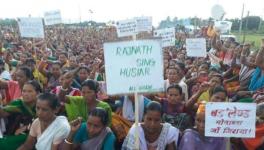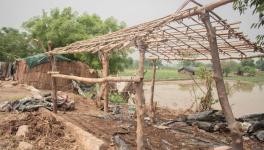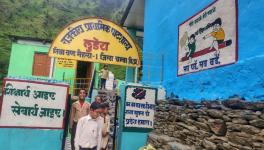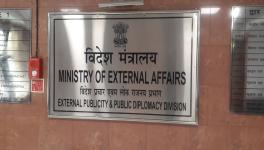Haryana and Himachal Pradesh Planning to Construct a Dam to "Revive" Saraswati River
The project to revive the extinct Saraswati river got significant impetus when the state governments of Himachal Pradesh (HP) and Haryana signed a memorandum of understanding to construct a dam on 77 acres in HP near the Adi Badri area of Yamuna Nagar recently. Haryana will bear the whooping project cost of Rs 215.35 crore and the expenditure involved in rehabilitating 21 families of HP who would be displaced due to this project. Chief Minister of HP Jai Ram Thakur and his Haryana counterpart Manohar Lal Khattar were present on this occasion.
A dam and a reservoir will be created at the origin point of the river and the religious tourist spots on the river route till Pehowa in Haryana. A portion of the Somb river — a tributary of the Yamuna that passes through Adi Badri — will be diverted to the dam from where it will flow into the stream of the Saraswati river with 20 cusecs of water, according to CM Khattar.
The state BJP government has been promoting this project ever since it came into power in 2014 and started excavation work of the river from the Rollaheri village of Yamuna Nagar district in 2015. Khattar, on the occasion of the signing of MoU, categorically stated that the signing of the MoU would realise Prime Minister Narendra Modi's dream of reviving the Saraswati river.
Saraswati is considered one of India's three ancient and sacred rivers- Ganga, Yamuna and Saraswati-. It is believed that due to tectonic disturbances in the area, Saraswati's Yamuna tributary was diverted to its present course, and Sutlej moved to the west, which resulted in the disappearance of the Saraswati river some 5000 years ago.
As per the state's pre-feasibility report for this project, the Saraswati river originated at Adi Badri, located around 40 kilometres away from Yamuna Nagar city of Haryana, at the foothills of the Shivalik mountains, near the Somb river of HP.
According to officials involved in the project, the dam and the reservoir will store around 224 hectare metre of water, of which 162 hectare metre will be stored to facilitate the flow of water in the Saraswati river; the remaining 62 meters of water will be allocated to HP. The Saraswati river will flow through 44 villages of the district for about 49 km. Most portion of the river has been excavated in Yamuna Nagar district. Khattar government has already approved 11 major projects, including restoration of various heritage sites along the course of the Saraswati.
Dhuman Singh Kirmach, vice president, Saraswati Heritage Development Board, claimed, "The project will provide multiple benefits such as water harvesting, water conservation, flood protection, underground water recharging, improvement in ecological balance and flourishing of flora and fauna."
However, river experts have revealed contrasting aspects. Manoj Misra, convener, Yamuna Jiye Abhiyan told NewsClick, "It is a totally unnecessary vanity project with political undertones at the cost of the Somb river- the sole Yamuna tributary in the state of Haryana." He rejected the methodology of the revival of Saraswati, saying, "A natural event had changed the fate of river Saraswati. So if it has to be revived, it should again be a natural event of a similar dimension and not a foolish dam-led effort at the hands of humans." He questioned the logic of keeping the river afloat with 20 cusec of water.
"What is 20 cusecs for a river? With the kind of temperatures increase we are seeing due to climate change during summers in North-West India, particularly in Haryana, it would be a total non-starter, and waste of public funds."
Harsh Vats, a research scholar with the Indian Institute of Remote Sensing, also questioned the methodology, saying, "It looks like the Haryana government is creating a canal and not reviving the river. The entire project is hogwash, the politicisation of religious sentiments and medium of minting money in the dam-building projects and through the spiritual and heritage tourism projects."
Vats keeps tweeting about the project. He tweeted that (it) might be the first instance where a dam is built to form a river.
Bhim Singh Rawat, an associate coordinator with South Asia Network on Dams Rivers And People (SANDRP), believes that the Haryana government is availing the maximum benefit of the Somb tributary of Yamuna through Hathini Kund Barrage (built on Yamuna river in Yamuna Nagar district ) but in return, it is only exploiting it through widespread sand mining and diverting its water.
"I had tweeted multiple satellite images to the Haryana Pollution Control Board officials where miners were shown collecting the mining material by making cross-sectional embankment to stop the river flow that NGT has prohibited. But no action was ever taken on this," he said, adding that pollution level across the Yamuna river is so bad that fishes, in large quantities, were found to be floating dead in the river in Greater Noida and a couple of other places.
"Yamuna is already facing a rainfall deficit for the past three years. Instead of replenishing it with flood water of Somb river during the rainy season, water will be diverted from it. This will prove to be a monumental folly. This way, neither dying Yamuna would be saved, nor extinct Saraswati could be revived."
Himanshu Thakkar, a coordinator of SANDRP, told NewsClick, "The diversion of water from the Yamuna will spell doom for its ecological flow and aquatic species surviving under it. An environment impact assessment involving both the rivers (Somb and Saraswati) should be conducted by independent agencies, the outcome of which should be put in the public domain. The government agencies like Central Ground Water Board which have been engaged in the project will say what the Central/state governments want them to."
He wondered how many states the Centre was planning to include in the Saraswati rejuvenation project where the river would flow in ancient times; the project comes at the cost of regional tributaries fighting for survival.
It is the local people who witness the damage to the ecology. People living close to the banks of the Yamuna river in Yamuna Nagar district recount how frantic mining activity has taken a toll on the river and its biodiversity.
Kiran Pal Rana, president of Yamuna Seva Samiti based in village Kanalsi in Yamuna Nagar district, said, "The rampant sand mining which continues day and night in the Yamuna river has not only badly affected the river water but also the creatures living in and out of the river. All the animals, such as peacocks, deer, nilgai, etc., abandoned the place due to disturbance caused by tractor trolleys. The fish abundance came to nought due to mining activity intruding even during fish spawning period in Monsoon season."
He said four children who slipped into the river for swimming have drowned in the last three years, as they had no idea of the deep pits dug into the river by miners.
Rajan K Panda, the convener at Water Initiative, suggested that the government should instead conduct geological studies and try to augment water through vigorous biological methods like plantations and making check-dams around the catchment area of Saraswati to revive the river naturally.
The writer is a Chandigarh based freelance journalist who tweets @seema_env. The views are personal.
Get the latest reports & analysis with people's perspective on Protests, movements & deep analytical videos, discussions of the current affairs in your Telegram app. Subscribe to NewsClick's Telegram channel & get Real-Time updates on stories, as they get published on our website.
























